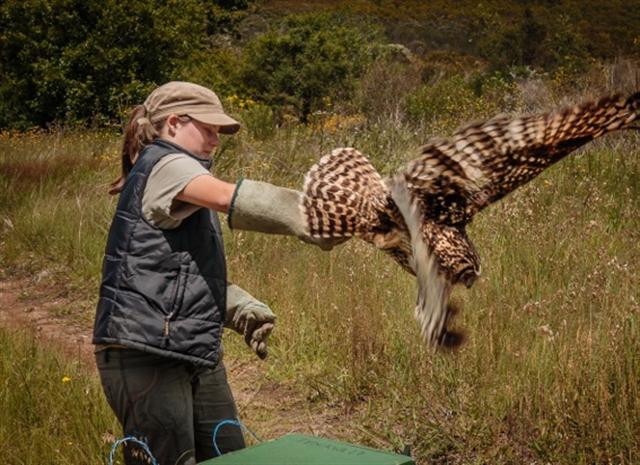He was released along the edge of the Whiskey Creek Reserve on the Redford Road in the Crags at the exact location he was found on the evening of October 10 by Jane Luck, who had been out walking her dogs.
"I noticed something that looked like rubbish hanging from the barbed wire fence running along the edge of the reserve. I hesitated, then stopped dead and stared at the rubbish. I wondered slowly and stupidly about it looking just like a bunch of large feathers hanging there," said Luck.
She was astonished when the 'rubbish' turned its yellow eyes on her, clacked its beak and hissed. The Cape Eagle-Owl was hanging from its shoulder, impaled on the barbs of the fence. Luck suspects that the owl had been there for days. After considering the needs of the bird, she decided to contact Tenikwa for help. She ran to the nearest neighbours and made the call. Mandy Freeman of Tenikwa rushed to the scene.
"Mandy was all calm efficiency. After getting a towel over the owl's head to stop it tearing our loving hands to shreds, and getting someone to hang on to its fierce talons, she slowly tried to separate the poor bird from the barbs impaling it," said Luck.
The owl was taken to the wildlife hospital at Tenikwa to have her wounds attended to and her body re-hydrated. "I felt so honoured to have been able to assist a magnificent and endangered owl back to life and freedom, and to save it from such a horrible slow death," said Luck.
According to Tenikwa's Wildlife Rehabilitation Centre's website (www.tenikwa.org), the owl's eye was unlikely to ever fully recover, but his vision was sufficient to survive in the wild.
Cape Eagle-Owls occur in small, irregular patches from Eastern Africa to Southern Africa, especially in the latter region. There are small distinctions in the appearance of the eagle-owls in the different areas. In the Southern areas they breed between June to September, nesting in sheltered rocky areas or on the ground under dense bushes. Their prey include small mammals, rodents and a supplementary diet of large insects and reptiles.
According to Wikipedia, Cape Eagle-Owl populations are deemed to be stable, but, "Predation of nests (especially ground nests) are common, as are roadkills and casualties due to power-wires and barbed wire. The use of pesticides to kill rodents may ultimately effect the species."

A bitter-sweet moment for Tenikwa's animal handler, Kim Allnutt who had been caring for this Cape Eagle Owl throughout his recovery and recently released the bird back into the wild. (Photo: David Collett.)
















